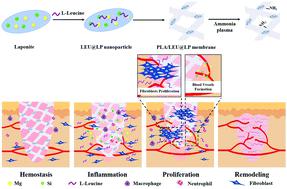当前位置:
X-MOL 学术
›
J. Mater. Chem. B
›
论文详情
Our official English website, www.x-mol.net, welcomes your feedback! (Note: you will need to create a separate account there.)
Leucine-activated nanohybrid biofilm for skin regeneration via improving cell affinity and neovascularization capacity.
Journal of Materials Chemistry B ( IF 7 ) Pub Date : 2020-07-16 , DOI: 10.1039/d0tb00958j Xiajie Lin 1 , Yamin Li , Wei Luo , Lan Xiao , Zeren Zhang , Jinzhong Zhao , Changsheng Liu , Yulin Li
Journal of Materials Chemistry B ( IF 7 ) Pub Date : 2020-07-16 , DOI: 10.1039/d0tb00958j Xiajie Lin 1 , Yamin Li , Wei Luo , Lan Xiao , Zeren Zhang , Jinzhong Zhao , Changsheng Liu , Yulin Li
Affiliation

|
The accumulation of skin diseases has increased the need for biomimicking materials with high bioactivity and biosafety for wound healing, where how to improve the cell affinity of the skin regenerative materials as well as their neovascularization capacity is a key factor for rapid regeneration of the injured skin tissue. In the current study, we developed an advanced type of biodegradable nanofibrous biofilm which can attract skin-related cells and accelerate blood vessel formation for skin regeneration. Firstly, bioactive nanohybrids (LEU@LP) were fabricated via in situ doping of the nutrient amino acid leucine (beneficial for fibroblast proliferation and protein synthesis) into LAPONITE® nanodisks (enriched in Mg and Si favorable for vascularization). LEU@LP nanoparticles were then hybridized with a biodegradable polylactide (PLA) nanofibrous mesh via an airbrushing technique, followed by a subsequent ammonia plasma surface treatment to improve PLA's hydrophilicity to increase cell affinity. The resulting hybrid biofilms with skin-biomimicking nanofibrous structural networks can promote cell adhesion, spreading, migration and proliferation of fibroblasts, leading to the ideal skin wound healing (with blood vessel formation and hair follicle regeneration), probably attributed to their better hydrophilicity to promote cell affinity and the capacity of sustainable release of leucine (beneficial for fibroblasts proliferation) and the composition provision (Mg and Si which are beneficial for neovascularization).
中文翻译:

亮氨酸激活的纳米杂交生物膜,可通过改善细胞亲和力和新血管形成能力来再生皮肤。
皮肤病的累积增加了对具有高生物活性和生物安全性的生物仿制材料进行伤口愈合的需求,其中如何提高皮肤再生材料的细胞亲和力及其新血管生成能力是受伤皮肤快速再生的关键因素组织。在当前的研究中,我们开发了一种先进的可生物降解的纳米纤维生物膜,它可以吸引与皮肤相关的细胞,并加速血管形成,促进皮肤再生。首先,通过原位制备生物活性纳米杂交体(LEU @ LP)将营养氨基酸亮氨酸(有益于成纤维细胞增殖和蛋白质合成)掺入LAPONITE®纳米盘(富含镁和硅,有利于血管生成)。LEU @ LP纳米粒子然后与可生物降解的聚乳酸(PLA)纳米纤维网状杂交经由喷枪技术,随后进行氨等离子体表面处理,以提高PLA的亲水性,从而增加细胞亲和力。产生的具有皮肤仿生纳米纤维结构网络的杂交生物膜可以促进成纤维细胞的细胞粘附,扩散,迁移和增殖,从而导致理想的皮肤伤口愈合(具有血管形成和毛囊再生),这可能归因于它们更好的亲水性以促进细胞亲和力和亮氨酸可持续释放的能力(有益于成纤维细胞增殖)和成分供应(有利于新血管形成的镁和硅)。
更新日期:2020-09-16
中文翻译:

亮氨酸激活的纳米杂交生物膜,可通过改善细胞亲和力和新血管形成能力来再生皮肤。
皮肤病的累积增加了对具有高生物活性和生物安全性的生物仿制材料进行伤口愈合的需求,其中如何提高皮肤再生材料的细胞亲和力及其新血管生成能力是受伤皮肤快速再生的关键因素组织。在当前的研究中,我们开发了一种先进的可生物降解的纳米纤维生物膜,它可以吸引与皮肤相关的细胞,并加速血管形成,促进皮肤再生。首先,通过原位制备生物活性纳米杂交体(LEU @ LP)将营养氨基酸亮氨酸(有益于成纤维细胞增殖和蛋白质合成)掺入LAPONITE®纳米盘(富含镁和硅,有利于血管生成)。LEU @ LP纳米粒子然后与可生物降解的聚乳酸(PLA)纳米纤维网状杂交经由喷枪技术,随后进行氨等离子体表面处理,以提高PLA的亲水性,从而增加细胞亲和力。产生的具有皮肤仿生纳米纤维结构网络的杂交生物膜可以促进成纤维细胞的细胞粘附,扩散,迁移和增殖,从而导致理想的皮肤伤口愈合(具有血管形成和毛囊再生),这可能归因于它们更好的亲水性以促进细胞亲和力和亮氨酸可持续释放的能力(有益于成纤维细胞增殖)和成分供应(有利于新血管形成的镁和硅)。



























 京公网安备 11010802027423号
京公网安备 11010802027423号